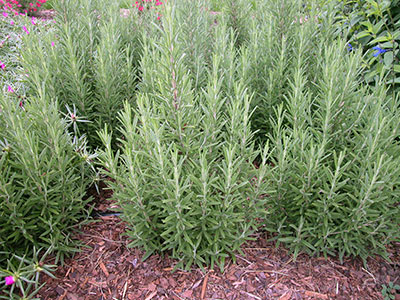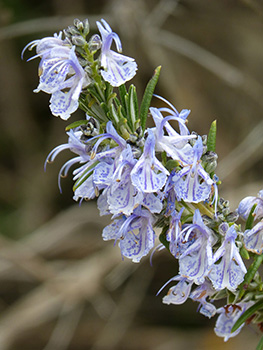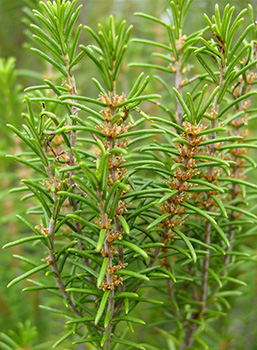Rosemary

Rosemary is a fragrant herb that can enhance both your cooking and your landscape. Its Latin name is Salvia rosmarinus (formerly Rosemarinus officinalis), with rosmarinus meaning “dew of the sea.” Rosemary is native to the Mediterranean region and is a member of the mint family.
This herb is often recommended to budding gardeners since it is easy to grow, drought tolerant, and relatively resistant to pests and diseases.
Characteristics
Rosemary’s narrow leaves are two to three centimeters long and emit a sharp, somewhat pine-like aroma when crushed. You can use them fresh in meals or dry them for later use. Rosemary is often used to season meats like pork, chicken, and lamb, but it's equally delicious when used on roasted potatoes or in soups and rustic breads. The woody stems also work well as skewers for kebobs.

Rosemary blooms in winter and spring with small pink, lavender, or blue flowers, depending on the cultivar. It makes a great addition to your pollinator garden since bees flock to the flowers.
Rosemary typically grows as a woody perennial or small shrub. It can reach up to six feet tall and four to five feet wide when planted in the ground but will remain smaller if pruned or planted in containers. Groundcover forms of rosemary are also available, including the ‘Prostratus' and ‘Creeping’ cultivars. Other popular cultivars include ‘Arp’, which is known for being cold-hardy, and ‘Tuscan Blue’, which has blue-violet flowers and a milder flavor.
Rosemary can also be trimmed into interesting topiary shapes. Around the holidays, many stores sell potted rosemary plants that have been trained to resemble small Christmas trees.
Planting and Care
Rosemary works well in containers and landscape beds. This Florida-Friendly plant will thrive year-round, although it may need to be protected from freezes in colder areas of the state. Plant rosemary in a container if you plan to bring it inside during the winter since it often does not survive moving after you put it in the ground.
It's best to buy rosemary plants from a garden center since it can be difficult to start them from seed. They are exceptionally easy to start from cuttings. You can learn more about propagation from cuttings in our article Plant Propagation.
Rosemary demands well-drained soil and at least six hours of sun. Dry conditions are ideal since rosemary suffers when overwatered. Too much fertilizer may reduce flowering and fragrance, so apply lightly. Since major pest and disease problems are uncommon, the main cause of plant decline is too much water.

Florida "rosemary" is inedible. Photo: James Henderson, Golden Delight Honey, Bugwood.org
For more information on rosemary, contact your county Extension office.
A Note
Be sure not to confuse culinary rosemary with Florida rosemary, sometimes called sand heath (Ceratiola ericoides). Although Florida rosemary looks similar to the herb and the crushed leaves smell the same, this native evergreen shrub is not edible. It plays an important role in Florida’s scrub plant communities, but it unfortunately is not a native alternative for edible, culinary rosemary.
Also on Gardening Solutions
- Five Fall Herbs for the Home Garden
- Fragrance Gardens
- Herbs
- Herbs for Your Pollinator Garden
- Holiday Gift Plants
- Mediterranean Gardens
- Rosemary Topiaries
- Super Drought-tolerant Plants
- Tough Plants

